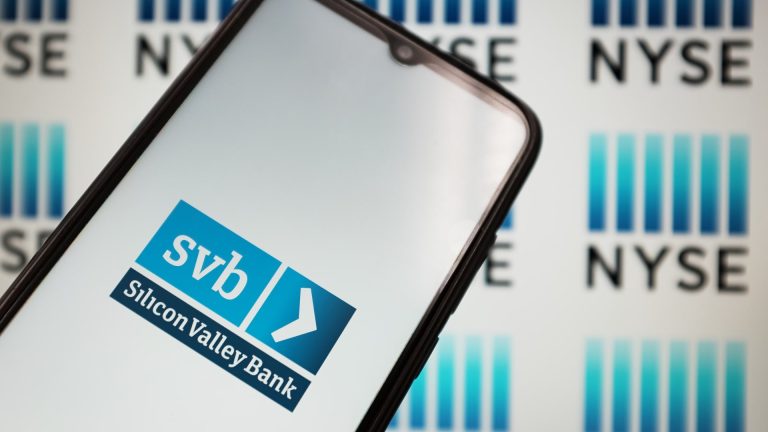
[ad_1]
In this photo illustration Silicon Valley Bank (SVB) logo seen displayed on a smartphone screen with NYSE (The New York Stock Exchange) logos in the background in Chania, Greece on March 13, 2023.
Nikolas Kokovlis | Nurphoto | Getty Images
Even my mother is happy with the Silicon Valley Bank rescue plan.
On a phone call last night, she expressed delight with the FDIC’s decision to make whole deposit holders at that bank. Not just for what it will do for Silicon Valley depositors, but for what it will due for holders of bank savings accounts around the country.
“The banks are going to have to give all of us savers more interest, and it’s about time,” she told me.
Wall Street strategists seem to agree with her.
“Another, as yet unquantifiable aspect of the current situation is that it will likely intensify the competition for retail deposits,” Chris Kotowski from Oppenheimer said in a note to clients Monday morning.
Other strategists noted the impact paying higher interest on deposits would have on net interest income and margins.
One thing’s for sure: Mom’s bank is going to have to work hard to earn her deposits. She keeps only a minimal amount in her savings account to pay her bills. The rest she has invested in bank CDs. My mother, the bond maven.
She has been crowing about her newfound love of bond investing and its relationship to the Silicon Valley Bank debacle.
She had called me a couple weeks before to tell me that she was about to roll over a one-year bank CD and was astonished that her local bank was offering her a yield over 4%.
“I couldn’t believe it, after all these years of getting nothing, they finally offered me something,” she said.
She was considering putting even more money into bank CDs and even asked about investing in short-term Treasurys, which is exactly what the whole country is doing: taking money out of their bank accounts and investing in government fixed income on the near end of the curve.
She is friendly with the bank tellers at several different banks in her town. All of them told her they would call her in the next week or so to let her know what yields they are offering.
No matter, as I pointed out, there was likely going to be little difference between the yields. She is going to pick the highest yielding one, even if it’s just 10 basis points.
“I don’t care if there’s not much difference, I just feel like my money matters more now,” she said.
My mother has become a bond shopper. And she loves it. She messaged me again this weekend.
“I’m watching TV all day to see what’s going on with the banks in California,” she said on Saturday. On a phone call, she correctly pointed out that in addition to deposit flight concerns much of the collateral damage caused to other banks was coming about because people like her were pulling money out of their bank accounts to buy Treasurys, which was going to squeeze profits at banks like hers.
Banks taking a beating
When I told her bank stocks had dropped 15% last week partly on worries of paying higher rates to depositors like hers, she was not sympathetic.
“Robert, the banks were not at all sympathetic to us for years when I was getting 0.4% on my savings accounts for the last 10 years,” she said. “Now I’m clapping my hands and I’m not feeling sorry for them.”
Over the weekend, traders were swapping notes about the massive moves Silicon Valley Bank created in trading on Thursday and Friday.
The good news appears to be, prices went into free-fall, but the plumbing did not break.
The equal-weight S&P Banking ETF was down 15% last week, closing at its lowest level in over two years, for a fund that included holdings in Silicon Valley Bank.
Volumes in the fund were among the highest ever recorded in the 18 year history of the KBE, outside of the 2008-2009 financial crisis. Leveraged bets like the Direxion Daily Regional Banks Bull 3X Shares also saw near historic volumes.
Trading through the ETFs did not prevent price drops, but it did provide an orderly and efficient method for traders to make bets for and against banks.
Long moves in short-duration bond funds
There have been other ripple effects.
There was massive trading in short-term Treasury ETFs like Vanguard Short-Term Treasury ETF, which tracks maturities of 1-3 years, and iShares Short Treasury Bond which tracks maturities of 1-12 months.
These ETFs have attracted enormous interest from investors worried about rising rates.
With financials representing 12% of the S&P 500, that drop in bank stocks was a major problem for the S&P 500 last week.
The S&P 500 closed at 3,861, its lowest level since mid-January. The Dow Jones Industrial Average turned negative for the year last week, down 3.7% in 2023.
The S&P 500 is on the verge of joining the Dow; it’s up a mere 0.6% for the year. The Nasdaq, up 6.4%, is running entirely on the January tech rally.
As Jonathan Krinsky at BTIG has noted, 3,925-3950 is the area with the most amount of volume traded over the last few years. For the moment, it looks like the S&P will climb back into that much more comfortable range.
[ad_2]
Source link